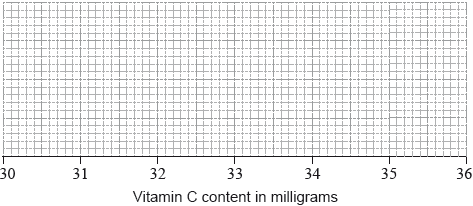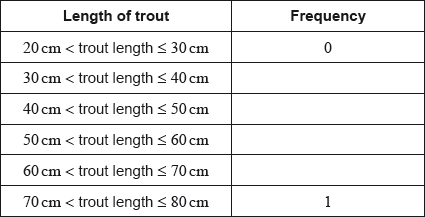| Date | November 2021 | Marks available | 2 | Reference code | 21N.1.SL.TZ0.9 |
| Level | Standard Level | Paper | Paper 1 | Time zone | Time zone 0 |
| Command term | Find | Question number | 9 | Adapted from | N/A |
Question
A group of students sat a history exam. The cumulative frequency graph shows the scores obtained by the students.
The students were awarded a grade from to , depending on the score obtained in the exam. The number of students receiving each grade is shown in the following table.
The mean grade for these students is .
Find the median of the scores obtained.
Find an expression for in terms of .
Find the number of students who obtained a grade .
Find the minimum score needed to obtain a grade .
Markscheme
A1
[1 mark]
recognition that all entries add up to (M1)
OR A1
[2 marks]
(M1)(A1)
Note: Award (M1) for attempt to substitute into mean formula, LHS expression is sufficient for the M mark. Award (A1) for correct substitutions in one variable OR in two variables, followed by evidence of solving simultaneously with .
A1
[3 marks]
their part (c)(i) seen (e.g. indicated on graph) (M1)
A1
[2 marks]
Examiners report
Most candidates were able to identify the median from the cumulative frequency graph in part (a). In part (b), attention to the demand of this part of the question would have turned one mark into two for a significant number of candidates. Candidates realized that the sum of the frequencies in the table should add up to , however, some neglected to make the subject of the formula.
In part (c)(i), there were mixed results when calculating the mean from the frequency table, with some candidates using only the frequencies and not including the grades in their calculation. Division by was often seen. More able candidates, however, did manage to arrive at the required value of . In part (c)(ii) some candidates scored follow-through marks from their incorrect value for but it seemed that many candidates did not realize that they had to use the cumulative frequency graph to find the answer.
Most candidates were able to identify the median from the cumulative frequency graph in part (a). In part (b), attention to the demand of this part of the question would have turned one mark into two for a significant number of candidates. Candidates realized that the sum of the frequencies in the table should add up to , however, some neglected to make the subject of the formula.
In part (c)(i), there were mixed results when calculating the mean from the frequency table, with some candidates using only the frequencies and not including the grades in their calculation. Division by was often seen. More able candidates, however, did manage to arrive at the required value of . In part (c)(ii) some candidates scored follow-through marks from their incorrect value for but it seemed that many candidates did not realize that they had to use the cumulative frequency graph to find the answer.
Most candidates were able to identify the median from the cumulative frequency graph in part (a). In part (b), attention to the demand of this part of the question would have turned one mark into two for a significant number of candidates. Candidates realized that the sum of the frequencies in the table should add up to , however, some neglected to make the subject of the formula.
In part (c)(i), there were mixed results when calculating the mean from the frequency table, with some candidates using only the frequencies and not including the grades in their calculation. Division by was often seen. More able candidates, however, did manage to arrive at the required value of . In part (c)(ii) some candidates scored follow-through marks from their incorrect value for but it seemed that many candidates did not realize that they had to use the cumulative frequency graph to find the answer.
Most candidates were able to identify the median from the cumulative frequency graph in part (a). In part (b), attention to the demand of this part of the question would have turned one mark into two for a significant number of candidates. Candidates realized that the sum of the frequencies in the table should add up to , however, some neglected to make the subject of the formula.
In part (c)(i), there were mixed results when calculating the mean from the frequency table, with some candidates using only the frequencies and not including the grades in their calculation. Division by was often seen. More able candidates, however, did manage to arrive at the required value of . In part (c)(ii) some candidates scored follow-through marks from their incorrect value for but it seemed that many candidates did not realize that they had to use the cumulative frequency graph to find the answer.




